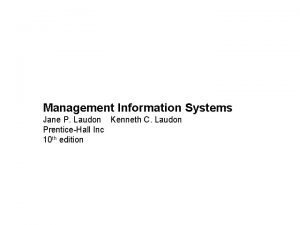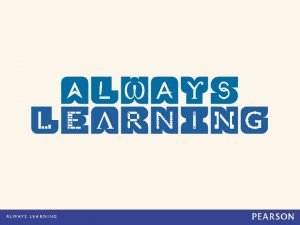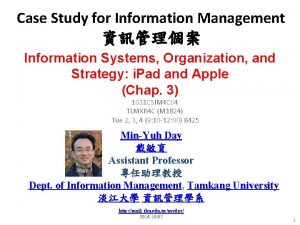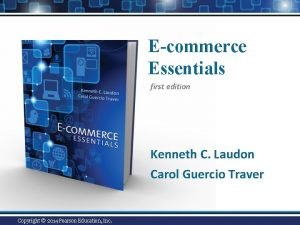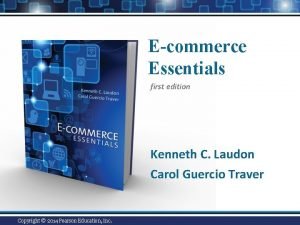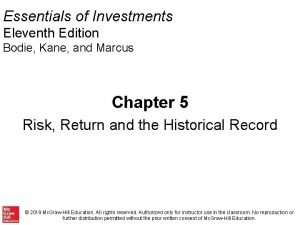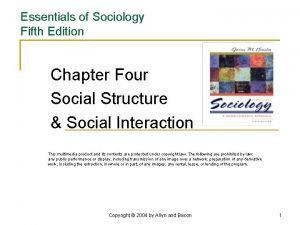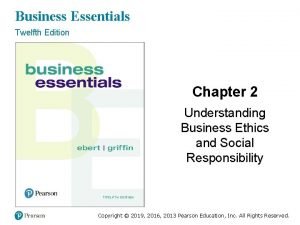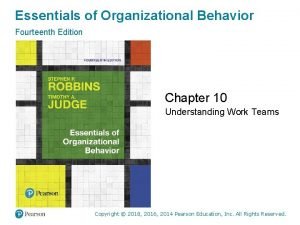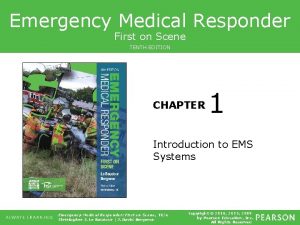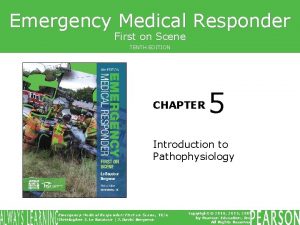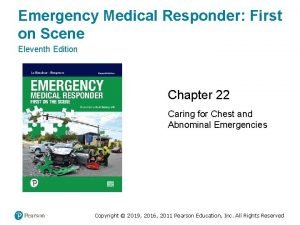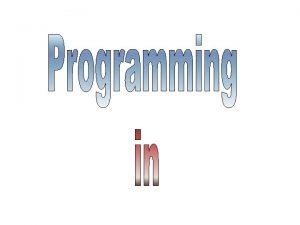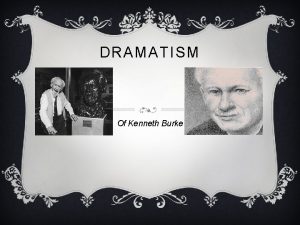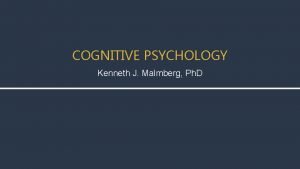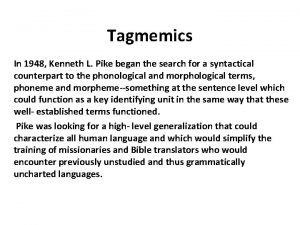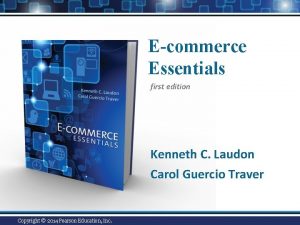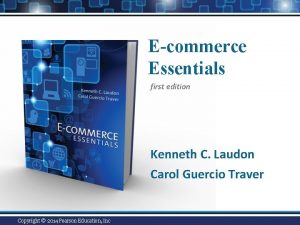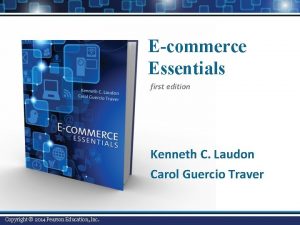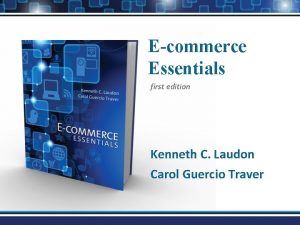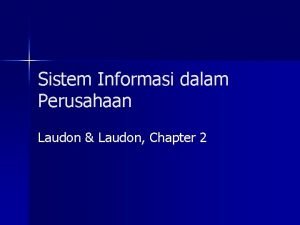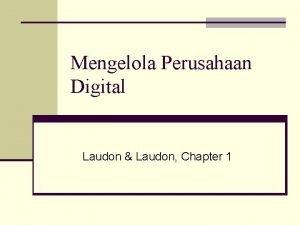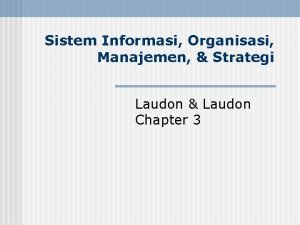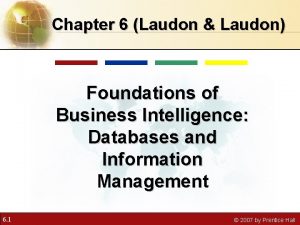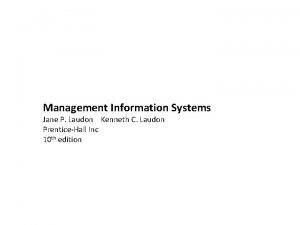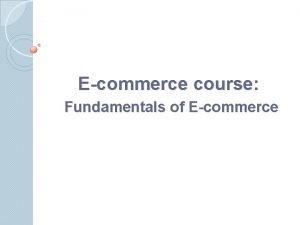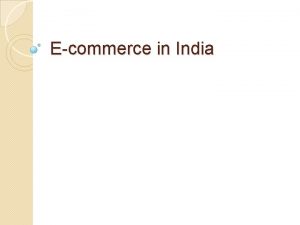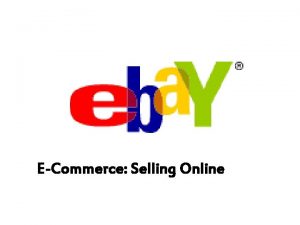Ecommerce Essentials first edition Kenneth C Laudon Carol



































- Slides: 35

E-commerce Essentials first edition Kenneth C. Laudon Carol Guercio Traver Copyright © 2014 Pearson Education, Inc.

Chapter 9 Online Content and Media Copyright © 2014 Pearson Education, Inc.

Class Discussion You. Tube and the Emerging Internet Broadcast System (IBS) n What types of online videos have you watched online, and on what devices? n What sites have given you the best overall viewing or entertainment experience, and why? n What advantages does watching traditional television have over watching online TV and films? Copyright © 2014 Pearson Education, Inc. Slide 9 -3

Online Content n Two major categories v Print industries v Online entertainment industries n Generated $15 billion in 2012 Copyright © 2014 Pearson Education, Inc. Slide 9 -4

Content Audience and Market n Average American adult spends 4, 200 hrs/yr consuming various media n 2012 media revenues: $488 billion n Over 77% of the hours spent consuming TV, radio, Internet n 2. 8 hrs/day on Internet usage doesn’t reduce TV viewing Copyright © 2014 Pearson Education, Inc. Slide 9 -5

Media Consumption Figure 9. 1, Page 350 Copyright © 2014 Pearson Education, Inc. SOURCE: Based on data from e. Marketer, Inc. , 2012 a, authors’ estimates Slide 9 -6

Internet and Traditional Media n Cannibalization vs. complementarity Does time on Internet reduce time spent with other media? v Books, newspapers, magazines, phone, radio v n Internet users Spend relatively less time with traditional media v Consume more media of all types than non-Internet users v n Multimedia—reduces cannibalization impact for some visual, aural media Copyright © 2014 Pearson Education, Inc. Slide 9 -7

Media Revenues by Channel Figure 9. 2, Page 352 Copyright © 2014 Pearson Education, Inc. SOURCE: Based on data from industry sources; authors’ estimates. Slide 9 -8

Digital Content Delivery Models n Online content delivery revenue models v Subscription v A la carte v Advertising supported (free/freemium) n Free content can drive users to paid content n Users increasingly paying for highquality, unique content Copyright © 2014 Pearson Education, Inc. Slide 9 -9

Online Content Consumption 2012 Figure 9. 3, Page 353 Copyright © 2014 Pearson Education, Inc. SOURCE: Based on data from industry sources; authors’ estimates. Slide 9 -10

Free or Fee? n Early years: Internet audience expected free content but willing to accept advertising v Early content was low quality n With advent of high-quality content, fee models successful v i. Tunes v 80 million buy from legal music sites v You. Tube cooperating with Hollywood production studios Copyright © 2014 Pearson Education, Inc. Slide 9 -11

Digital Rights Management (DRM) n DRM: Technical and legal means to protect digital content from unlimited reproduction and distribution n Cloud-based/streaming services make traditional DRM software less necessary n Apple and Amazon use “walled garden” to prevent sharing of content from their devices Copyright © 2014 Pearson Education, Inc. Slide 9 -12

Online Publishing Industry n $82 billion based originally in print, moving rapidly to Internet n Three segments v. Online newspapers v. E-books v. Online magazines Copyright © 2014 Pearson Education, Inc. Slide 9 -13

Online Newspapers n Most troubled segment of publishing industry v Failure to protect content from free distribution v 60% have reduced news staff n However: v Online readership growing at over 10% v Mobiles, tablets provide new avenues v More users willing to pay for premium content v Aggregators are recognizing need for high-quality content to distribute and use for advertisements Copyright © 2014 Pearson Education, Inc. Slide 9 -14

Monthly Unique Visitors at Online Newspapers Figure 9. 6, Page 357 Copyright © 2014 Pearson Education, Inc. SOURCE: Based on data from Myers, 2012 Slide 9 -15

Newspaper Business Models n Initially fee-based, then free, and now beginning a return to fee-based n Newspaper headlines are primary content on Google News, Yahoo News n New York Times now charging for premium access n Newspaper efforts to ally with Internet titans n New reader devices with reader apps Copyright © 2014 Pearson Education, Inc. Slide 9 -16

Insight on Society: Class Discussion Can Apps and Videos Save Newspapers? Have you read a newspaper using an app? n Have you paid for any online newspaper or article? How much would you pay for a single article? n Would you prefer to watch online news videos produced by a TV station or by a newspaper such as the New York Times? n What other opportunities could help the industry recover from the decline in print sales? n Copyright © 2014 Pearson Education, Inc. Slide 9 -17

E-books and Online Publishing n E-book sales have exploded in recent years—$4. 2 billion in 2012 n New channel for self-publishing authors v Amanda Hocking’s My Blood Approves (2010) n Evolution v Project Gutenberg (1970 s) v Voyager’s books on CD (1990 s) v Adobe’s PDF format Copyright © 2014 Pearson Education, Inc. Slide 9 -18

New Digital Ecosystems n E-book hardware, software, combined with online megastores v Amazon Kindle: Linked to Amazon store and cloud storage v Apple i. Pad: Multipurpose tablet, linked to Apple stores n Authors able to bypass traditional agent, publisher channels n DRM more effective than for music industry Copyright © 2014 Pearson Education, Inc. Slide 9 -19

Challenges of E-book Platform n Cannibalization v Fewer physical sales v More e-book sales, more purchases of readers n Finding the right business model v Wholesale model n Retailers pay wholesale price and establish retail price v Agency model n Distributor as agent must charge publisher’s retail price n Converging technologies v Interactive books v i. Book Author, i. Book Textbooks Copyright © 2014 Pearson Education, Inc. Slide 9 -20

E-book Sales Figure 9. 7, Page 361 Copyright © 2014 Pearson Education, Inc. SOURCE: Based on data from e. Marketer, 2012 b. Slide 9 -21

Magazines Rebound n Magazine circulation plummets 1980– 2012 v Rise in online video and online news readership, and increases costs of color printing, 2001: 22 million n 2011: 11 million n n 2012: Digital magazine readership doubled to 3. 29 million copies v Tablets a major factor n Magazine aggregators Copyright © 2014 Pearson Education, Inc. Slide 9 -22

Online Entertainment Industry n Four traditional players, one newcomer v. Television v. Radio broadcasting v. Hollywood films v. Music v. Video games (new arrival) Copyright © 2014 Pearson Education, Inc. Slide 9 -23

Online Entertainment Industry n Internet is transforming industry v Platform development n Smartphones, tablets, music platform n Online streaming and cloud storage n Social networks as distributors v Viable business models n Music subscription services n Closed platforms that eliminate need for DRM v Widespread growth of broadband Copyright © 2014 Pearson Education, Inc. Slide 9 -24

Online Entertainment Audience Size n Online “traditional” entertainment v Online video has largest audiences, followed by music, games n User-generated content v Substitutes for and complements traditional commercial entertainment v Two dimensions User focus n User control n v Sites that offer high levels of both will grow Copyright © 2014 Pearson Education, Inc. Slide 9 -25

Projected Growth in Online Entertainment Figure 9. 9, Page 366 Copyright © 2014 Pearson Education, Inc. SOURCES: Based on data from industry sources; authors’ estimates. Slide 9 -26

Television and Premium Video n TV industry transitioning to new delivery platforms n OTT: Over-the-top (Internet) delivery n Three factors in TV industry transformation v Broadband penetration v New mobile platforms v Willing industry with library of high-quality content n Social network influences Copyright © 2014 Pearson Education, Inc. Slide 9 -27

Movies n Mobile and tablet growth fueling demand for online movies n Unlike music industry, no one distributor dominates n Three types of online movie sales Subscription video on demand (SVOD) n Transactional video on demand (TVOD) n Electronic sell-through n n Reduced DVD sales n Release windows system Copyright © 2014 Pearson Education, Inc. Slide 9 -28

Online Movie Business Share of Movie Revenues Figure 9. 11, page 370 Copyright © 2014 Pearson Education, Inc. Slide 9 -29

Insight on Technology: Class Discussion Hollywood and the Internet: Let’s Cut a Deal What challenges has the Internet posed to traditional Hollywood movie distribution? What is the biggest challenge? n Can Internet distribution work with the “release window” strategy? n Do you think Hollywood is doing a better job of protecting its content than the music industry? n What is the most realistic and profitable path forward for the Hollywood film industry? n Copyright © 2014 Pearson Education, Inc. Slide 9 -30

Music n Most changed of content industries v Move from physical to digital product v Unbundling of single songs v Distributor market dominated by Apple n Digital revenues account for majority of all revenues (52%) for first time in 2011 n Streaming services—fastest growth v Variety of revenue models Copyright © 2014 Pearson Education, Inc. Slide 9 -31

Consumer Spending on Digital Music Figure 9. 12, page 373 Copyright © 2014 Pearson Education, Inc. Slide 9 -32

Games n Online gaming has had explosive growth n Types of online gamers n Casual n Social n Mobile—fastest growing market n Console n Business models in flux n Most online/mobile games offered for free Copyright © 2014 Pearson Education, Inc. Slide 9 -33

Online Gaming Audience Figure 9. 13, page 375 Copyright © 2014 Pearson Education, Inc. Slide 9 -34

Copyright © 2014 Pearson Education, Inc. Slide 9 -35
 Kenneth c. laudon jane p. laudon
Kenneth c. laudon jane p. laudon Laudon laudon schoder
Laudon laudon schoder Management information system case study
Management information system case study Management information system case study
Management information system case study E-commerce presence map
E-commerce presence map Kenneth c. laudon
Kenneth c. laudon Ken ott ecommerce
Ken ott ecommerce Network security essentials 5th edition
Network security essentials 5th edition Business essentials 12th edition chapter 1
Business essentials 12th edition chapter 1 Essentials of investments 11th edition
Essentials of investments 11th edition Business essentials 12th edition
Business essentials 12th edition Essentials of sociology 5th edition
Essentials of sociology 5th edition Firefighter essentials 7th edition
Firefighter essentials 7th edition Business essentials 12th edition
Business essentials 12th edition Management information systems 13th edition
Management information systems 13th edition Types of group
Types of group At a bulk transport incident firefighters must
At a bulk transport incident firefighters must Network security essentials 5th edition
Network security essentials 5th edition Criminal justice the essentials 5th edition
Criminal justice the essentials 5th edition Using mis (10th edition) 10th edition
Using mis (10th edition) 10th edition Zulily case study
Zulily case study Kinder- und hausmärchen first edition
Kinder- und hausmärchen first edition Emergency medical responder: first on scene
Emergency medical responder: first on scene Cardiopulmonary
Cardiopulmonary Emergency medical responder first on scene 11th edition
Emergency medical responder first on scene 11th edition Kunci jawaban buku rosen
Kunci jawaban buku rosen Dr kenneth gorski
Dr kenneth gorski Kenneth nelson sofi
Kenneth nelson sofi Kenneth lane thompson
Kenneth lane thompson Kenneth einar himma
Kenneth einar himma He is the author of icnofalangometrica.
He is the author of icnofalangometrica. Kenneth burke dramatism
Kenneth burke dramatism Kenneth malmberg
Kenneth malmberg Dr kenneth wang
Dr kenneth wang Kenneth røn christiansen
Kenneth røn christiansen K l pike
K l pike
